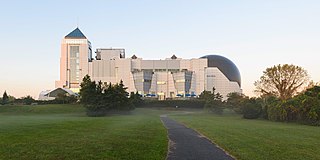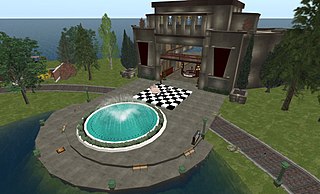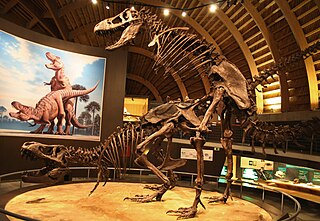
A science museum is a museum devoted primarily to science. Older science museums tended to concentrate on static displays of objects related to natural history, paleontology, geology, industry and industrial machinery, etc. Modern trends in museology have broadened the range of subject matter and introduced many interactive exhibits. Modern science museums, increasingly referred to as 'science centres' or 'discovery centres', also feature technology.

The Science Museum is a major museum on Exhibition Road in South Kensington, London. It was founded in 1857 and is one of the city's major tourist attractions, attracting 3.3 million visitors annually in 2019.
The Oregon Museum of Science and Industry is a science and technology museum in Portland, Oregon, United States. It contains three auditoriums, including a large-screen theatre, planetarium, and exhibition halls with a variety of hands-on permanent exhibits focused on natural sciences, industry, and technology. Transient exhibits span a wider range of disciplines.

The Ontario Science Centre, formally the Centennial Museum of Science and Technology, is a science museum in Toronto, Ontario, Canada. It is located near the Don Valley Parkway about 11 kilometres (6.8 mi) northeast of downtown on Don Mills Road in the former city of North York. It is built down the side of a wooded ravine formed by one branch of the Don River located in Flemingdon Park. Premier Doug Ford announced 18 April 2023 the Ontario government's general plan to replace the Ontario Science Centre with a smaller new institution on the Toronto waterfront.

Liberty Science Center is an interactive science museum and learning center located in Liberty State Park in Jersey City, New Jersey, United States. At its opening, it was the largest such planetarium in the Western Hemisphere and the world's fourth largest.

The International Spy Museum is an independent non-profit history museum which documents the tradecraft, history, and contemporary role of espionage. It holds the largest collection of international espionage artifacts on public display. The museum opened in 2002 in the Penn Quarter neighborhood of Washington, D.C., and relocated to L'Enfant Plaza in 2019.

The Museum of Science (MoS) is a science museum and indoor zoo in Boston, Massachusetts, located in Science Park, a plot of land spanning the Charles River. Along with over 700 interactive exhibits, the museum features a number of live presentations throughout the building every day, along with shows at the Charles Hayden Planetarium and the Mugar Omni Theater, the only domed IMAX screen in New England. The museum is also an accredited member of the Association of Zoos and Aquariums (AZA) and is home to over 100 animals, many of which have been rescued and rehabilitated.

The Science Museum of Minnesota is an American museum focused on topics in technology, natural history, physical science, and mathematics education. Founded in 1907 and located in Saint Paul, Minnesota, the 501(c)(3) nonprofit institution has 385 employees and is supported by volunteers.
Star Wars: Where Science Meets Imagination is a traveling exhibition created by the Museum of Science, Boston, featuring props and costumes used in the Star Wars films, but focusing primarily on the science behind George Lucas' science fiction epic. Star Wars: Where Science Meets Imagination was developed by Boston's Museum of Science, in collaboration with Lucasfilm Ltd., with the support of the National Science Foundation, under Grant No. 0307875. This exhibit is presented nationally by Bose Corporation.

The National Science Museum Thailand (NSM) is a state enterprise established on 30 January 1995 under the Ministry of Higher Education, Science, Research and Innovation. NSM develops and currently operates 4 museums and 2 learning centers to raise public awareness of science for Thai society. The museums are the Science Museum, Natural History Museum, Information Technology Museum and RAMA 9 Museum. All the museums are located at Technopolis Khlong 5, Khlong Luang, Pathum Thani. The NSM's learning centers are NSM Science Square @ the Street Ratchada located in Bangkok and NSM Science Square @ Chiang Mai located in Princess Siridhorn AstroPark.

COSI, officially the Center of Science and Industry, is a science museum and research center in Columbus, Ohio. COSI was opened to the public on 29 March 1964 and remained there for 35 years. In 1999, COSI was moved to a 320,000-square-foot (30,000 m2) facility, designed by Japanese architect Arata Isozaki along a bend in the Scioto River in the Franklinton neighborhood. COSI features more than 300 interactive exhibits throughout themed exhibition areas.

A virtual museum is a digital entity that draws on the characteristics of a museum, in order to complement, enhance, or augment the museum experience through personalization, interactivity, and richness of content. Virtual museums can perform as the digital footprint of a physical museum, or can act independently, while maintaining the authoritative status as bestowed by the International Council of Museums (ICOM) in its definition of a museum. In tandem with the ICOM mission of a physical museum, the virtual museum is also committed to public access; to both the knowledge systems imbedded in the collections and the systematic, and coherent organization of their display, as well as to their long-term preservation.

The National Museum of Nuclear Science & History is a national repository of nuclear science information chartered by the 102nd United States Congress under Public Law 102-190, and located in unincorporated Bernalillo County, New Mexico, with an Albuquerque postal address. It is adjacent to both the Albuquerque city limits and Kirtland Air Force Base.

The Catalyst Science Discovery Centre and Museum is a science and technology museum in Widnes, Halton, North-West England. The centre has interactive exhibits, reconstructed historical scenes, an observatory, a live-science theatre and family workshops. It is next to Spike Island, a public park, located between the River Mersey and the Sankey Canal that has woodlands, wetlands, footpaths and industrial archaeological history.

The Canada Science and Technology Museum is a national museum of science and technology in Ottawa, Ontario, Canada. The museum has a mandate to preserve and promote the country's scientific and technological heritage. The museum is housed in a 13,458 square metres (144,860 sq ft) building. The museum is operated by Ingenium, a Crown corporation that also operates two other national museums of Canada.

Exhibit design is the process of developing an exhibit—from a concept through to a physical, three-dimensional exhibition. It is a continually evolving field, drawing on innovative, creative, and practical solutions to the challenge of developing communicative environments that ‘tell a story’ in a three-dimensional space.

An exhibition, in the most general sense, is an organized presentation and display of a selection of items. In practice, exhibitions usually occur within a cultural or educational setting such as a museum, art gallery, park, library, exhibition hall, or World's fairs. Exhibitions can include many things such as art in both major museums and smaller galleries, interpretive exhibitions, natural history museums and history museums, and also varieties such as more commercially focused exhibitions and trade fairs.

The Berlin Spy Museum is a private museum in Berlin which was created by former journalist Franz-Michael Günther. The museum opened to the public on the 19th of September 2015. Günther's aspirations were to create a museum devoted to the history of spies and espionage in the former spy capital of Germany. The museum is located in the central area of Potsdamer Platz, formerly known as the "death strip", as it lies on the perimeters of the wall which once divided East and West Berlin. The museum acts as an educational institution, with its permanent exhibitions bridging together centuries of espionage stories and tactics, immersing visitors in a multi-media experience. The museum particularly focuses on the World Wars and the Cold War through a range of a 1000 different exhibits and artefacts. Since its opening in 2015, 1,000,000 people have visited the museum and recently in 2020 it was nominated for the European Museum of the Year Award. The Berlin Spy Museum is partnered with the International Spy Museum in Washington, D.C., and many of the artefacts and installations within the museum have captured media attention around the world.

SPYSCAPE is a contemporary edutainment brand focused on secrets. SPYSCAPE's physical HQ in New York City uses immersive stories and experiences to help people uncover their own potential. The 60,000-square-foot museum & experience was created by London-based private investment group Archimedia and designed by Sir David Adjaye.

















